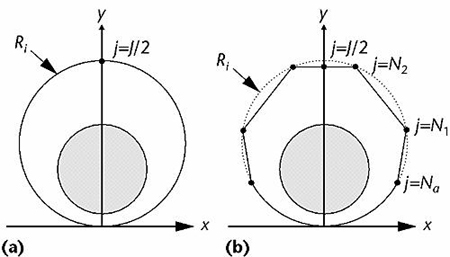Geometric Techniques
Weil's Technique
Agui et al's Technique
Geometric methods to model cloth are aimed at recreating the "look" of cloth and not
its properties. This method is mainly employed by computer graphic people who are
only trying to create images of the cloth that look realistic enough to be believed, but
don't need the cloth to have the exact characteristics of cloth.
Weil
Weil was one of the first people to attempt to simulate cloth. His technique is the basis for
almost all other techniques that have been developed since. The method that he created was
to represent hanging cloth as a grid or points. He simulated its shape by fitting catenary
curves between hanging restraint points. His method can be broken down into a two stage process.
The first stage is to approximate a solution to the shape of the cloth and the second state is to
apply certain restraints to the first stage to get a more realistic look.
The first step of the first stage is to set the cloth onto a square grid. This grid will be a
representation of the cloth. The second step is to pick a triangle and hang a catenary curve
from one of its corners to the midpoint of the other side of the triangle. Weil uses this equation for
the catenary:

The next step is to move all of the points that lie on the line created by the catenary to the
catenary curve. A rasterized line is drawn between the two end points of the catenary curve. The
number of points that make up this line are counted and uniformly divide the catenary by this number.
The points are then moved onto their corresponding location on the catenary.

If there are still points that are not lying on the catenary withing the two triangles created by the
splitting of the original triangle with the catenary, then the above process is repeated on these new
triangles. The process is repeated on every triangle until all points are represented by a
catenary. This splitting process can be seen below.

One problem with the steps discussed above is that there are more than one way to split a triangle
with a catenary. To fix this problem a new catenary should be created that takes the original two
into account. While this may solve the problem, it creates many calculations. Instead Weil decided to
simply use the lower of the two catenaries. This solution solves the problem in a less computational way.
The only problem with picking the lowest catenary is that during an animation the lower catenary may
change from one frame to another creating a "snapping effect."

The second stage of the process is to apply restraints to the cloth shape to allow for a more
realistic look. Weil did this through the use of a relaxation algorithm. During the first stage
many of the points on the grid get moved into a location that would not be possible in a real
cloth. The relaxation algorithm makes sure that the points are all located in relatively the
same distance from each other as they were in their initial state.
The first step in this process is to constuct displacement vectors between each point and its neighbors.
The resultant displacement vector of the individual displacement vectors is then used to displace the
point by some value to attempt to decrease the magniture of the overall displacement. This process is
repeated over the whole grid until d_max (total displacement of the grid) is less than L (original distance
to neighbors) + some tolerance factor. The displacement vectors are displayed below.

This method creates rather realistic looking cloth models. An example of this method can be
seen below in the images of a ghostly shaped cloth model.

Agui et al
Agui and his colleges create a method to model cloth on a bending arm. They represented
cloth as a hollow cylinder consisting of a series of circular rings. The image below is
of the representation that they used.

Agui et al observed that folds formed as a direct consequence of the difference in
curvature between the intter and out part of a bent sleeve. They were able to derive
the following equation from this observation.

L(i,j) is the distance between the points P_i,j and P_i-1,j. dL(i,j) is the difference in distance
before and after a bend. They determined that a deformation (fold) occurs when dL(i,j) is at a minimum.
A before an after image of a bending is shown below.

Folds are created by transforming the circular rings into polygons. The image below
whow the circle R_i on the xy-plane before and after it is split into polygons. The
shaded circle inside or R_I is the representations of the arm. To make the computations
simple the circles are assumed to by symmetric about the y-axis. The first step in turning
the rings into polygons is to find a point N_a where dL(i,j) is greater than some
predetermined threshold dL_a. The parts of the circle below the point N_a are not
changed and remain in circular form. The next step is to locate points N_1 and N_2 with
thresholds dL_1 and dL_2 where dL_2 > dL_1 > dL_a. The algorithm
that they used always assigns the top of the sleep to be flat. This is based on the assumption
that folds are always flat near the top of the sleeve. This process is applied to all circles that
makeup the sleeve. the corners are smoothed smoothed and averaged before rendering.











